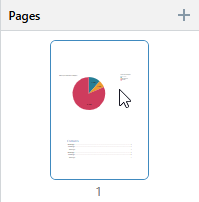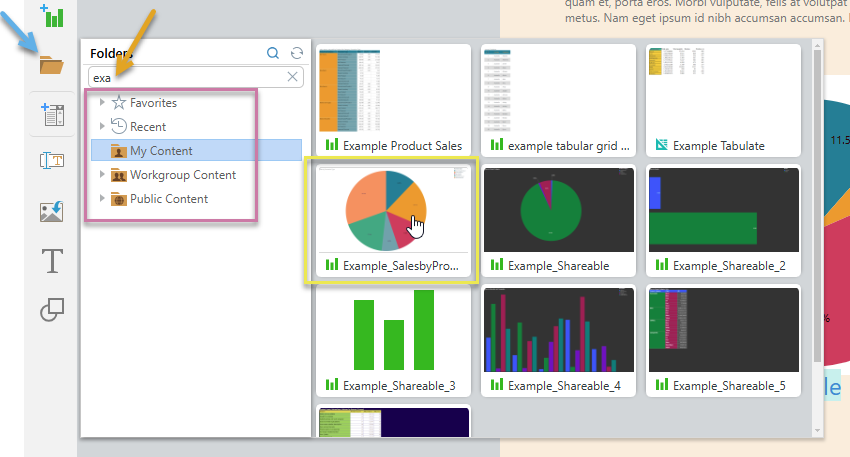Add existing analytic content (Discover visuals or Tabulate visual areas) to your publication from the content management system or by dragging open items in from the App Tabs. These content items were typically created by you or your colleagues using Discover or Tabulate and saved to a shared location; reusing them in this publication ensures that you are always including the latest underlying analytic data from your team.
As an alternative, you might want to create and add brand new "one-off" visuals that only exist within this publication. For more information, see:
- Creating Visuals using Discover Lite (Publish Lite).
- Creating Visuals using Smart Reporting (Publish Lite).
Note: You must have sufficient rights to access the visuals in the content management system to be able to see them in the Content Manager and add them to your publication.
Adding existing visuals
Before you begin
If you want to add visuals from the content management system, you or your colleagues need to have already created and saved them in advance of this task. The saved visuals must be available in the content tree in locations that you have access to. The content items may include existing:
- Visuals, created in Discover.
- Visual areas, defined in a Tabulate spreadsheet. Note: You cannot add a whole spreadsheet to your publication.
- Illustrations, created in Illustrate.
You also need to have created the publication that you want to add your visual to. For details, seeBuilding a New Publication in Publish Lite.
Step 1: Select a page
Before you begin, you need to open the page that you want to add your visual to. This may be a page that already exists in your publication or a new page created for the visual.
From the Pages panel:
- Select the relevant snapshot.

The selected page is highlighted in the Pages panel and opens on the canvas for editing.
Tip: You can also add a new page by clicking the Plus (+) icon at the top-right of the Pages panel.
The page opens on the canvas.
Step 2: Add your visual
Add a visual from the Toolbox
- From the left-hand Toolbox, click Content (blue highlight, below).
- Locate the visual, visual area, or illustration that you want to add to your page:
- If you know part or all of its name, type that value into the Search field (orange arrow).
- Alternatively, you can navigate to the item through the folder tree structure (purple highlight).
By default, the search tries to match your string with the beginning of your search term, so if you enter "sch" it searches for results with names starting with "sch". However, if you type "*sch" (prefixing with an asterisk) it searches for results whose name contains "sch" anywhere.
The folder tree includes your Favorites and Recent files, your personal files (My Content), files informally shared by you and other users that share your role (Workgroup Content), and any available Public Content. For more information about this structure, see Content Explorer.
- From the Results panel, select the visual you want to add to your publication (yellow highlight).
The Folders panel opens.

If the result contains further selectable items, you may need to make two selections. For example, if a Tabulate spreadsheet contains visual areas, you will select the spreadsheet first and then the visual area.
Add an open visual from the App tabs
Note: You can only add a visual to your publication following these steps if the visual has already been saved to the content management system.
From the App tabs along the bottom of your page:
- Click the tab that represents the visual you want to add, and drag it onto the publication:

What next?
Once you have added your visual, you might want to:
- Resize your visual: Select the panel and drag its handles to fit the space.
- Rename your visual: Right-click the panel, select Rename Title, and supply a new title.
You might also want to add additional content items to the canvas, including additional visuals, text, shapes, images, and so on.
Other tools
You might want to open your visual in Discover, Illustrate, or Tabulate to update it. Given the appropriate access rights, you can do this using the Open options on the right-click context menu.
Overriding existing slicers
If a visual includes its own slicer (typically added during creation in Discover or Smart Reporting), its default filter is preserved when added to a publication. For example, a pie chart filtered by Manufacturer will retain the original selection (say, ACME). To override this selection, add a new slicer with the same data hierarchy to the publication and create an interaction between the visual and the new slicer. For more information, see Creating Slicers in Publish Lite.